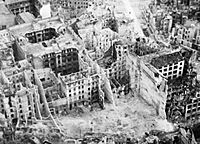Bombing of Berlin in World War II facts for kids
During World War II, the city of Berlin, which was the capital of Germany, faced many air attacks. From 1940 to 1945, Berlin was hit by 363 air raids. These attacks were part of a bigger plan by the Allied forces to bomb important targets in Germany.
The main air forces involved in bombing Berlin were the RAF (from Britain), the USAAF (from the United States), and the French Air Force. The Red Air Force (from the Soviet Union) also attacked Berlin, especially in 1945 as their ground forces got closer to the city. British planes dropped a huge amount of bombs, over 45,000 tons, while American planes dropped about 23,000 tons.
These constant bombings had a big impact on the people living in Berlin. As the attacks continued, many residents decided to leave the city to find safety. By May 1945, about 1.7 million people, which was 40% of Berlin's population, had left their homes and fled.
Contents
Why Berlin Was Bombed
Strategic Bombing Campaign
The bombings of Berlin were part of a strategy called "strategic bombing." This meant that the Allied forces wanted to destroy Germany's ability to fight the war. They targeted factories, transportation hubs, and other important places. The goal was to weaken Germany's military and economy.
Targeting Important Cities
Berlin was a very important target because it was the capital city. It was home to many government buildings, military headquarters, and factories that made war supplies. By bombing Berlin, the Allies hoped to disrupt Germany's leadership and lower the morale of its people.
Who Bombed Berlin?
Royal Air Force (RAF) Attacks
The British RAF Bomber Command started bombing Berlin early in the war, in 1940. Their attacks often happened at night. They used many planes to drop bombs on the city. The RAF continued these raids throughout the war, aiming to cause widespread damage.
United States Army Air Forces (USAAF) Raids
The USAAF joined the bombing campaign later, starting in 1943. American bombers usually flew during the daytime. This allowed them to aim more precisely at specific targets. They often faced strong resistance from German air defenses.
French and Soviet Air Forces
The French Air Force also took part in some bombing missions over Berlin from 1944. In 1945, as the Soviet forces advanced towards Berlin, the Red Air Force carried out many attacks. These bombings were often in support of their ground troops fighting to capture the city.
Impact on Berlin and Its People
Destruction of the City
The air raids caused massive destruction across Berlin. Many buildings, homes, and historical sites were turned into rubble. The city's infrastructure, like roads and railways, was severely damaged. This made daily life very difficult for the people who remained.
Life During the Bombings
People in Berlin lived in constant fear of air raids. They often spent nights in air-raid shelters, which were underground bunkers designed to protect them from bombs. Food and other supplies became scarce, and conditions were very tough.
Mass Exodus from Berlin
As the war continued and the bombings grew more intense, many people decided they had to leave Berlin. This mass movement of people, known as an exodus, meant that nearly half of the city's population had fled by the end of the war. They sought safety in other parts of Germany or with relatives.
Images for kids
-
People in London look at a map illustrating how the RAF is striking back at Germany during 1940
See also
 In Spanish: Bombardeos de Berlín en la Segunda Guerra Mundial para niños
In Spanish: Bombardeos de Berlín en la Segunda Guerra Mundial para niños







